|
Battle of Lynchburg, Virginia
Other Names: None
Location: City of Lynchburg
Campaign: Lynchburg Campaign (May-June 1864); 1864 Shenandoah Valley Campaigns
Date(s): June 17-18, 1864
Principal Commanders: Maj. Gen. David Hunter [US]; Lt. Gen. Jubal
A. Early [CS]
Forces Engaged: Corps (44,000 total)
Estimated Casualties: 900 total
Result(s): Confederate victory
| Civil War Battle of Lynchburg, Virginia |
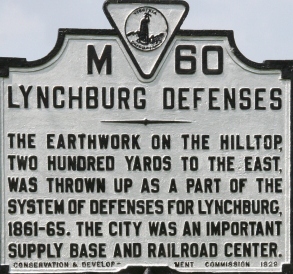
|
| Lynchburg Civil War Historical Marker |
Description: From Lexington, Maj. Gen. David Hunter advanced
against the Confederate rail and canal depots and the hospital complex at Lynchburg. Reaching the outskirts of town on June
17, his first tentative attacks were thwarted by the timely arrival by rail of Lt. Gen. Jubal A. Early’s II Corps vanguard
from Charlottesville. Hunter withdrew the next day after sporadic fighting because of a critical shortage of supplies.
His line of retreat through West Virginia took his army out of the war for nearly a
month and opened the Shenandoah Valley for a Confederate advance into Maryland.
Setting the Stage: At the beginning of
1864, Ulysses S. Grant was promoted to lieutenant general and given command of all Union armies. He chose to make his headquarters
with the Army of the Potomac, although Maj. Gen. George G. Meade remained the actual commander of that army. He left Maj.
Gen. William Tecumseh Sherman in command of most of the western armies. Grant understood the concept of total war and believed,
along with Sherman and President Abraham Lincoln, that only the utter defeat of Confederate forces and their economic base
would bring an end to the war. Therefore, scorched earth tactics would be required in some important theaters. He devised
a coordinated strategy that would strike at the heart of the Confederacy from multiple directions: Grant, Meade, and Maj.
Gen. Benjamin Butler against Robert E. Lee's Army of Northern Virginia near Richmond; Maj. Gen. Franz Sigel to invade the
Shenandoah Valley and destroy Lee's supply lines; Sherman to invade Georgia and capture Atlanta; Maj. Gen. Nathaniel Banks
to capture Mobile, Alabama.
| Battle of Lynchburg Map |
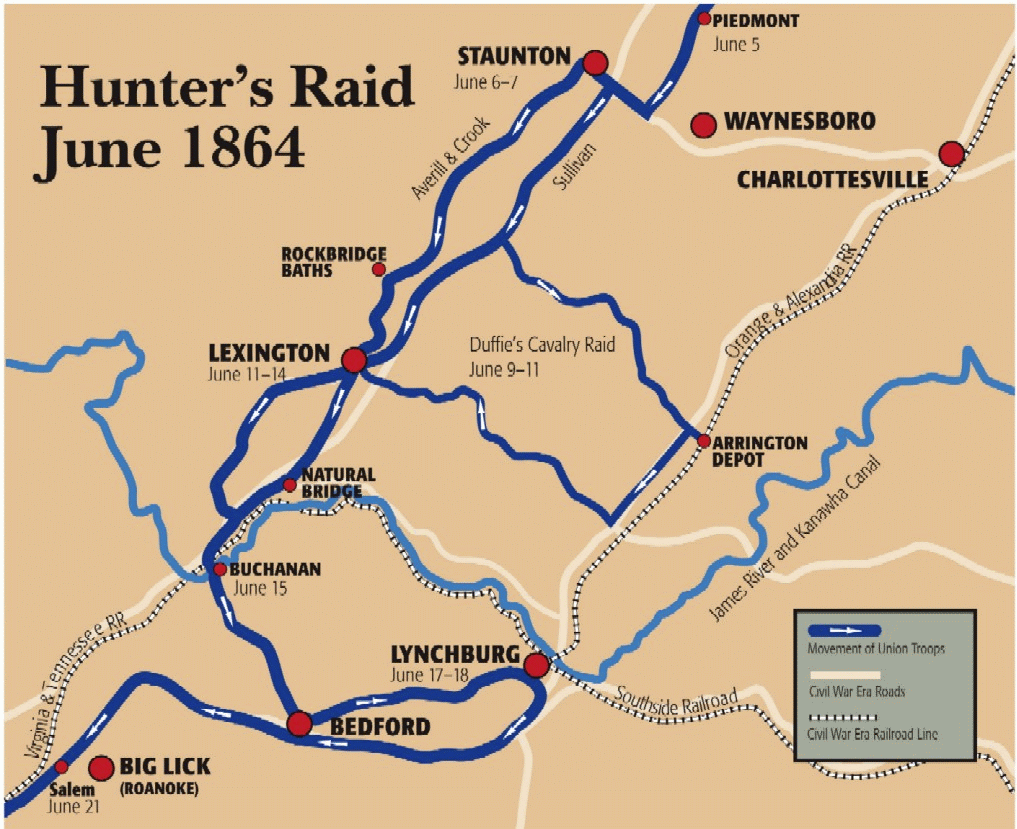
|
| Civil War Battle of Lynchburg Map |
The Battle of Lynchburg was one of many battles fought during
the Lynchburg Campaign. The Lynchburg Campaign, also known as Hunter's Lynchburg Campaign, Hunter's Campaign, and Hunter's
Raid, was part of the 1864 Shenandoah Valley Campaigns and was the first of three principal campaigns fought throughout the valley
region.
Lynchburg Campaign [May-June 1864] consisted of the following battles:
New Market – Piedmont – Lynchburg.
Although not geographically part of the Shenandoah Valley, Lynchburg served as a major rail and canal center, supply depot, and
hospital complex for the Confederacy. Produce from the Upper Valley
could be shipped there by road or stream and thence to Richmond on the James
River Canal, the Southside Railroad, or the O&A Railroad via
Charlottesville and Gordonsville. The Southside Railroad linked
Richmond with the western Confederacy through its connections
with the Virginia & Tennessee Railroad. The Southside Railroad continued to supply Richmond,
with interruptions from Federal raiders, until the Battle of Five Forks (1 April 1865).
| Battle of Lynchburg |
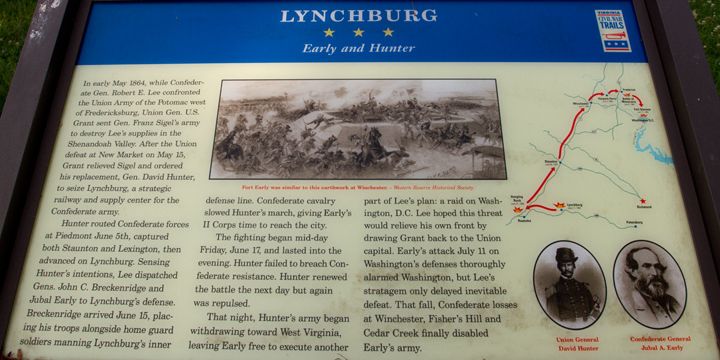
|
| Civil War Lynchburg Battle |
| Lynchburg Campaign Map |
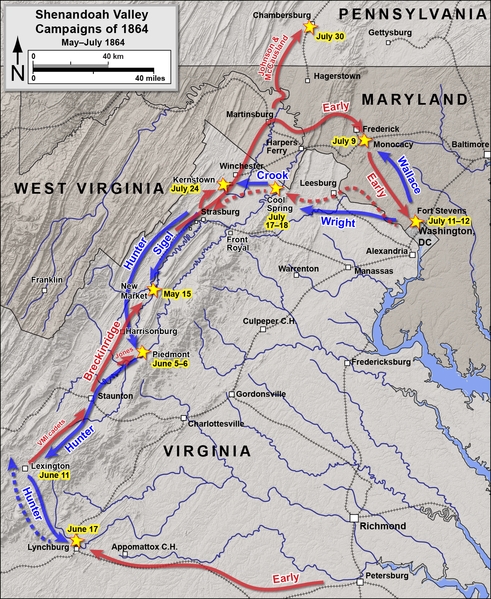
|
| Battle of Lynchburg Map |
As the war progressed, Lynchburg, too, became an important objective of Union campaigns
in the Valley. In 1864, several expeditions--up the Valley from Winchester, and north from
Bulls Gap, Tennessee--were devised to capture Lynchburg,
but the city remained in Confederate hands until the end of the war.
For the Union, defending the vulnerable B&O Railroad and the line
of the Potomac River were essential considerations for any operations in the Shenandoah Valley.
Because of implicit threats against Washington, a small
Confederate army in the Valley could pin down three to five times its number in Union defenders, threaten vital Union transportation
and communication lines, and carry the war to the North, if opportunity presented itself.
As the war continued, the Shenandoah Valley
increased in importance to the Southern cause, and correspondingly it became more urgent that the Northern armies succeed
there after dramatic failures in 1862, 1863, and May 1864. Ultimately, the Northern army was forced to lay waste to the agricultural
abundance of the Valley in order to destroy support for the Southern war effort.
The Battle of Lynchburg was the third and final battle of the Lynchburg Campaign. Following Maj. Gen. Sigel's
poor performance at New Market, he was relieved of command and then replaced by Maj. Gen. Hunter. Having enjoyed recent success
at Piedmont, Hunter moved on Lynchburg in a concerted effort to press and roll Gen. Lee's flank. After the failed Union attempt,
two more campaigns would unfold during the Valley Campaigns: the Confederate Maryland Campaign and the Union Shenandoah
Valley Campaign. While Lt. Gen. Jubal Early would enjoy many battlefield successes, he would ultimately find himself fleeing
from Maj. Gen. Phil Sheridan with only his staff, and then relieved of command by Gen. Lee. The following month would
witness Lee surrendering to Grant.
| Battle of Lynchburg Battlefield Map |
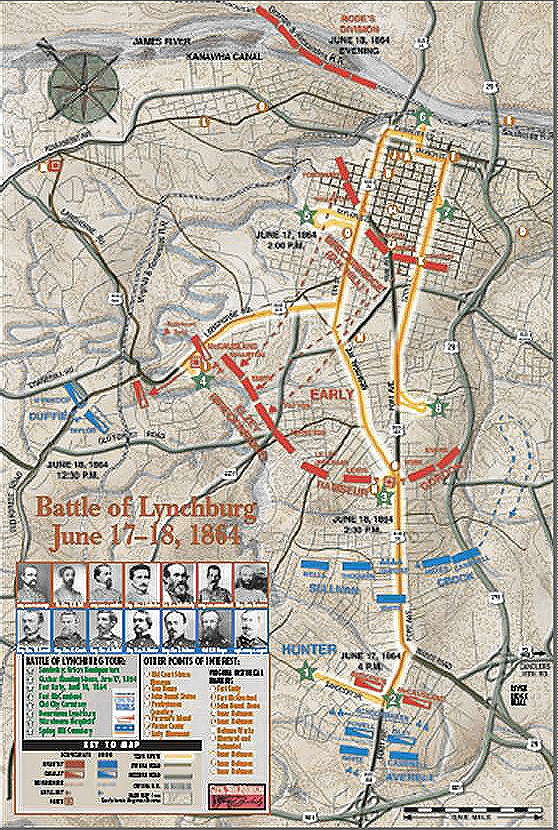
|
| Civil War Battle of Lynchburg |
Battle: Early
arrived in Lynchburg at one o'clock on June 17, having been sent by General Robert E. Lee. Three hours later, Averell encountered
McCausland's and Imboden's dismounted cavalry entrenched at the Quaker Meeting House, four miles from the city. The Confederates
were driven back after Col. Carr B. White's brigade moved in to support Averell. Two brigades of Major General Stephen Dodson
Ramseur's division occupied the area around a redoubt two miles from the city and hindered the Union advance.
Hunter made Sandusky his headquarters and planned the attack on Early's
defenses. That night, trains could be heard moving up and down the tracks. Also, various instruments such as bugles and drums
were heard by Hunter's troops. Even the people of Lynchburg made noise by having bands play and citizens scream. Their goal
was to make the Confederate army seem larger than it really was.
| Battle of Lynchburg Map |
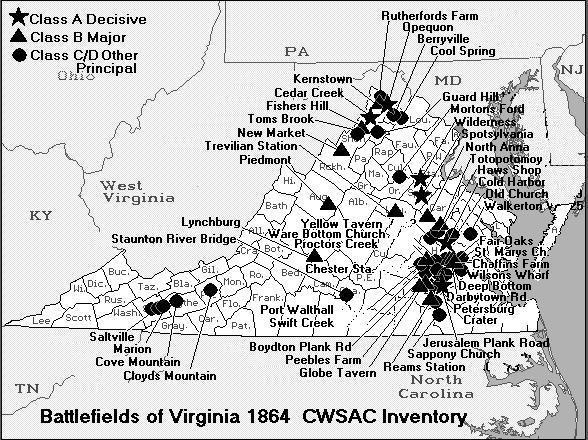
|
| Civil War Battle of Lynchburg Battlefield Map |
| Fort Early |
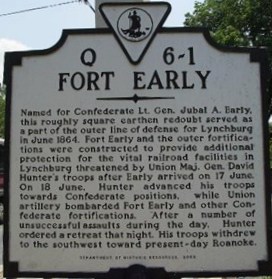
|
| Civil War Fort Early, Battle of Lynchburg |
On June 18, Major Generals Arnold Elzey and Robert Ransom, Jr. arrived from
the Confederate capital of Richmond, Virginia. Elzey assumed command of Breckinridge's infantry and dismounted cavalry while
Ransom superseded Imboden as commander of the mounted cavalry. Early elected to remain defensive and wait for the rest of
the Second Corps to arrive. The redoubt now known as Fort Early was at the center of the Confederate line, with Maj. Gen.
John Brown Gordon's division on the left and Brig. Gen. William G. Lewis's brigade on the right. McCausland commanded the
right flank, which included a redoubt, and Elzey's command defended the area between it and Lewis' brigade.
Col. Scott Shipp's VMI cadets were placed in reserve at Spring Hill Cemetery
while the inner defenses were occupied by the Confederate Home Guard.
Hunter, still not convinced that Lee had sent reinforcements to Lynchburg,
deployed Sullivan's and Crook's divisions in front of the Confederate center, with Averell in reserve, and sent an order to
Duffié to attack the Confederate right. Reconnoitering the line in an effort to find a weak spot to push his infantry through,
Hunter ruled out a direct attack on the redoubts, for they appeared too strong. He allowed Lt. Col. Henry A. du Pont to deploy
his thirty-two cannons. Crook was sent to flank the Confederate left, but marched a few miles before finding it impracticable.
The Confederates attacked Sullivan and du Pont, who managed to hold them at bay until Crook returned. The Confederates fell
back after a half hour of fighting, but spent the next hour and twenty minutes attempting to break through the gap between
Sullivan and Duffié before withdrawing to their earthworks. A regiment of Col. Rutherford B. Hayes' brigade pursued them but
were beaten back.
(Right) Fort Early Historical Marker
Meanwhile, McCausland succeeded in holding off Duffié's assaults. As ammunition
ran short, both Hunter and Duffié became convinced that they were outnumbered. Early then prepared to begin an attack of his
own, but Hunter retreated at nightfall.
| Battle of Lynchburg, Virginia |
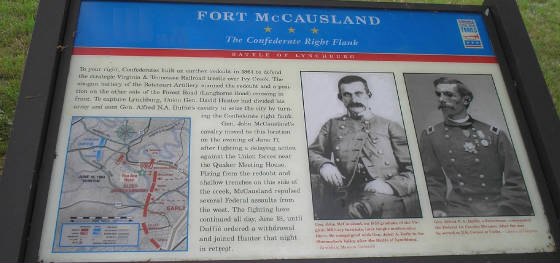
|
| Civil War Lynchburg Battle |
| Battle of Lynchburg, Virginia |
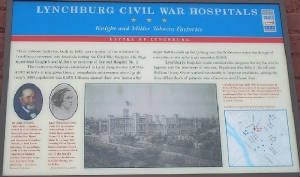
|
| Lynchburg Civil War Campaign |
| Civil War Battle of Lynchburg |
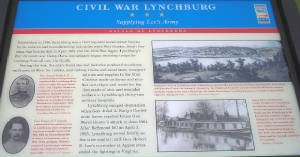
|
| Civil War Lynchburg |
| Civil War Battle of Lynchburg Map |

|
| Battle of Lynchburg, Virginia, Map |
Timeline
1757: Lynchburg is founded when John Lynch establishes a ferry service along
the banks of the James River.
1860: Lynchburg has a population of 6,853, including 3,802 free whites,
357 free blacks, and 2,694 enslaved African Americans.
May 23, 1861: Lynchburg unanimously voices its approval to leave the
Union in a statewide referendum.
June 17, 1864: During the Battle of Lynchburg, Confederate troops under
the command of Jubal A. Early drive off the forces of Union general David Hunter, whose retreat cedes control of the Shenandoah
Valley back to the Confederates.
April 6–10, 1865: The state government relocates to Lynchburg.
When Union forces chase renegade remnants of Robert E. Lee's Army of Northern Virginia into the town shortly after the Confederate
surrender on April 9, they find a city on the verge of chaos and civic leaders who are eager to make peace.
| Gen. Early's route from Lynchburg to Washington |
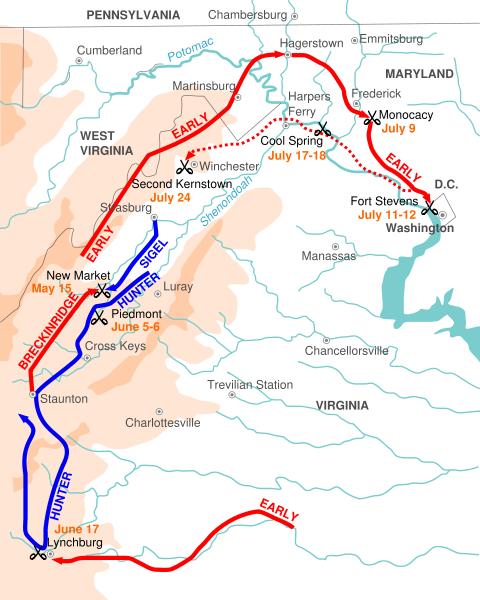
|
| Numerous Civil War battles were fought along this route |
| Lynchburg and Civil War Spies |
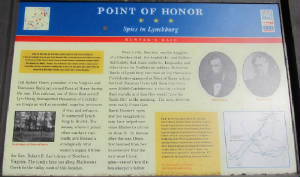
|
| Civil War Spies of Lynchburg |
Aftermath and Analysis: Lynchburg, which served as a Confederate supply base,
was approached within 1-mile (1.6 km) by the Union forces of General David Hunter as he drove south from the Shenandoah Valley.
Under the false impression that the Confederate forces stationed in Lynchburg were much larger than anticipated, Hunter was
repelled by the forces of Confederate General Jubal Early on June 18, 1864, in the Battle of Lynchburg. To create the false
impression, a train was continuously run up and down the tracks while the citizens of Lynchburg cheered as if reinforcements
were unloading. Local prostitutes also took part in the deception, misinforming their Union clients of the large
number of Confederate reinforcements.
(Right) Civil War Spies and Battle of Lynchburg.
The Battle of Lynchburg was fought on June 17–18, 1864, less than two miles outside Lynchburg,
Virginia, as part of the American Civil War. The Union Army of West Virginia, under Maj. Gen. David Hunter, attempted to capture
the city but was repulsed by Confederate Lt. Gen. Jubal Anderson Early.
Then, Early's army moved sixty miles in three days chasing Hunter. At that point, Early halted the
pursuit and awaited for Hunter to make a move. Hunter decided to move across the Shenandoah Valley and into West Virginia.
(Sources and related reading listed below.)
Recommended
Reading: The
Shenandoah Valley Campaign of 1864 (McFarland & Company). Description: A
significant part of the Civil War was fought in the Shenandoah Valley of Virginia, especially in 1864. Books and articles
have been written about the fighting that took place there, but they generally cover only a small period of time and focus
on a particular battle or campaign. Continued below...
This work covers
the entire year of 1864 so that readers can clearly see how one event led to another in the Shenandoah Valley and turned once-peaceful
garden spots into gory battlefields. It tells the stories of the great leaders, ordinary men, innocent civilians, and armies
large and small taking part in battles at New Market, Chambersburg, Winchester, Fisher’s
Hill and Cedar Creek, but it primarily tells the stories of the soldiers, Union and Confederate,
who were willing to risk their lives for their beliefs. The author has made extensive use of memoirs, letters and reports
written by the soldiers of both sides who fought in the Shenandoah Valley in 1864.
Recommended
Reading: The
Shenandoah Valley Campaign of 1864 (Military Campaigns of the Civil War) (416 pages) (The University of North
Carolina Press). Description: The 1864 Shenandoah Valley Campaign
is generally regarded as one of the most important Civil War campaigns; it lasted more than four arduous months and claimed
more than 25,000 casualties. The massive armies of Generals Philip H. Sheridan and Jubal A. Early had contended for immense
stakes... Beyond the agricultural bounty and the boost in morale to be gained with its numerous battles, events in the Valley
would affect Abraham Lincoln's chances for reelection in November 1864. Continued below...
The eleven
essays in this volume reexamine common assumptions about the campaign, its major figures, and its significance. Taking advantage
of the most recent scholarship and a wide range of primary sources, contributors examine strategy and tactics, the performances
of key commanders on each side, the campaign's political repercussions, and the experiences of civilians caught in the path
of the armies. The authors do not always agree with one another, but, taken together, their essays highlight important connections
between the home front and the battlefield, as well as ways in which military affairs, civilian experiences, and politics
played off one another during the campaign.
Recommended
Reading: From Winchester to Cedar Creek: The Shenandoah Campaign
of 1864. Amazon.com Review: Virginia's Shenandoah Valley was a crucial avenue for Confederate armies
intending to invade Northern states during the Civil War. Running southwest to northeast, it "pointed, like a giant's lance,
at the Union's heart, Washington, D.C.,"
writes Jeffry Wert. It was also "the granary of the Confederacy," supplying the food for much of Virginia. Both sides long understood its strategic importance, but not until the fall of
1864 did Union troops led by Napoleon-sized cavalry General Phil Sheridan (5'3", 120 lbs.) finally seize it for good. He defeated
Confederate General Jubal Early at four key battles that autumn. Continued below…
In addition
to a narrative of the campaign (featuring dozens of characters, including General George Custer and future president Rutherford
B. Hayes), this book is a study of command. Both Sheridan and Early were capable military leaders, though
each had flaws. Sheridan tended to make mistakes before battles,
Early during them. Wert considers Early the better general, but admits that few could match the real-time decision-making
and leadership skills of Sheridan once the bullets started
flying: "When Little Phil rode onto the battlefield, he entered his element." Early was a bold fighter, but lacked the skills
necessary to make up for his disadvantage in manpower. At Cedar Creek, the climactic battle of the 1864 Shenandoah campaign,
Early "executed a masterful offensive against a numerically superior opponent, only to watch it result in ruin." With more
Confederate troops on the scene, history might have been different. Wert relates the facts of what actually happened with
his customary clarity and insightful analysis.
Recommended
Reading: Field Armies and Fortifications in the Civil War: The Eastern Campaigns,
1861-1864 (Civil War America) (Hardcover). Description: The eastern campaigns of the Civil War involved the widespread use of field fortifications, from Big Bethel and the
Peninsula to Chancellorsville, Gettysburg, Charleston,
and Mine Run. While many of these fortifications were meant to last only as long as the battle, Earl J. Hess argues that their
history is deeply significant. The Civil War saw more use of fieldworks than did any previous conflict in Western history.
Hess studies the use of fortifications by tracing the campaigns of the Army of the Potomac
and the Army of Northern Virginia from April 1861 to April 1864. He considers the role of field fortifications in the defense
of cities, river crossings, and railroads and in numerous battles. Continued below...
Blending technical
aspects of construction with operational history, Hess demonstrates the crucial role these earthworks played in the success
or failure of field armies. He also argues that the development of trench warfare in 1864 resulted from the shock of battle
and the continued presence of the enemy within striking distance, not simply from the use of the rifle-musket, as historians
have previously asserted. Based on fieldwork at 300 battle sites and extensive research in official reports, letters, diaries,
and archaeological studies, this book should become an indispensable reference for Civil War historians.
Recommended
Reading: Stonewall in the Valley: Thomas J. Stonewall Jackson's Shenandoah Valley Campaign,
Spring 1862. Description: The Valley Campaign
conducted by Maj. Gen. Thomas J. "Stonewall" Jackson has long fascinated those interested in the American Civil War as well
as general students of military history, all of whom still question exactly what Jackson
did in the Shenandoah in 1862 and how he did it. Since Robert G. Tanner answered many questions in the first edition of Stonewall
in the Valley in 1976, he has continued to research the campaign. This edition offers new insights on the most significant
moments of Stonewall's Shenandoah triumph. Continued below…
About the Author:
Robert G. Tanner is a graduate of the Virginia Military Institute. Tanner is a native of Southern California, he now lives
and practices law in Atlanta, Georgia. He has studied and lectured
on the Shenandoah Valley Campaign for more than twenty-five years.
Recommended
Reading: Shenandoah Summer:
The 1864 Valley Campaign. Description:
Jubal A. Early’s disastrous battles in the Shenandoah Valley ultimately resulted in
his ignominious dismissal. But Early’s lesser-known summer campaign of 1864, between his raid on Washington and Phil
Sheridan’s renowned fall campaign, had a significant impact on the political and military landscape of the time. By
focusing on military tactics and battle history in uncovering the facts and events of these little-understood battles, Scott
C. Patchan offers a new perspective on Early’s contributions to the Confederate war effort—and to Union battle
plans and politicking. Patchan details the previously unexplored battles at Rutherford’s Farm and Kernstown (a pinnacle
of Confederate operations in the Shenandoah Valley) and examines the campaign’s influence
on President Lincoln’s reelection efforts. Continued below…
He also provides
insights into the personalities, careers, and roles in Shenandoah of Confederate General John C. Breckinridge, Union general
George Crook, and Union colonel James A. Mulligan, with his “fighting Irish” brigade from Chicago.
Finally, Patchan reconsiders the ever-colorful and controversial Early himself, whose importance in the Confederate military
pantheon this book at last makes clear. About the Author: Scott C. Patchan, a Civil War battlefield guide and historian, is
the author of Forgotten Fury: The Battle of Piedmont, Virginia, and a consultant and contributing writer for Shenandoah, 1862.
Review
"The author's
descriptions of the battles are very detailed, full or regimental level actions, and individual incidents. He bases the accounts
on commendable research in manuscript collections, newspapers, published memoirs and regimental histories, and secondary works.
The words of the participants, quoted often by the author, give the narrative an immediacy. . . . A very creditable account
of a neglected period."-Jeffry D. Wert, Civil War News (Jeffry D. Wert Civil War News 20070914)
"[Shenandoah
Summer] contains excellent diagrams and maps of every battle and is recommended reading for those who have a passion for books
on the Civil War."-Waterline (Waterline 20070831)
"The narrative
is interesting and readable, with chapters of a digestible length covering many of the battles of the campaign."-Curled Up
With a Good Book (Curled Up With a Good Book 20060815)
"Shenandoah
Summer provides readers with detailed combat action, colorful character portrayals, and sound strategic analysis. Patchan''s
book succeeds in reminding readers that there is still plenty to write about when it comes to the American Civil War."-John
Deppen, Blue & Grey Magazine (John Deppen Blue & Grey Magazine 20060508)
"Scott C. Patchan
has solidified his position as the leading authority of the 1864 Shenandoah Valley Campaign with his outstanding campaign
study, Shenandoah Summer. Mr. Patchan not only unearths this vital portion of the campaign, he has brought it back to life
with a crisp and suspenseful narrative. His impeccable scholarship, confident analyses, spellbinding battle scenes, and wonderful
character portraits will captivate even the most demanding readers. Shenandoah Summer is a must read for the Civil War aficionado
as well as for students and scholars of American military history."-Gary Ecelbarger, author of "We Are in for It!": The First
Battle of Kernstown, March 23, 1862 (Gary Ecelbarger 20060903)
"Scott Patchan
has given us a definitive account of the 1864 Valley Campaign. In clear prose and vivid detail, he weaves a spellbinding narrative
that bristles with detail but never loses sight of the big picture. This is a campaign narrative of the first order."-Gordon
C. Rhea, author of The Battle of the Wilderness: May 5-6, 1864 (Gordon C. Rhea )
"[Scott Patchan]
is a `boots-on-the-ground' historian, who works not just in archives but also in the sun and the rain and tall grass. Patchan's
mastery of the topography and the battlefields of the Valley is what sets him apart and, together with his deep research,
gives his analysis of the campaign an unimpeachable authority."-William J. Miller, author of Mapping for Stonewall and Great
Maps of the Civil War (William J. Miller)
Sources: National Park Service; Civil War Trust; Official Records of the Union
and Confederate Armies; National Archives; Christian, W. Asbury. Lynchburg and Its People. Lynchburg: J.P. Bell, 1900.
|

